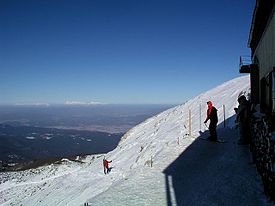Snežnik, Slovenia (mountain)
| Snežnik | |
| Mountain plateau | |
|
View from Big Mount Snežnik (Veliki Snežnik). To the right, the Drago Karolin Lodge.
|
|
| Country | Slovenia |
|---|---|
| Region | Inner Carniola |
| Part of | Dinaric Alps |
| Highest point | Big Mount Snežnik (Veliki Snežnik) |
| - elevation | 1,796 m (5,892 ft) |
| - coordinates | 45°34′53.45″N 14°25′53.55″E / 45.5815139°N 14.4315417°E |
| Geology | Sedimentary |
| Period | Cretaceous, Jurassic |
Snežnik (pronounced [snɛˈʒniːk]; Italian: Monte Nevoso) is a wide karst limestone plateau with an area of about 85 km2 (33 sq mi) in the Dinaric Alps of Slovenia. It mainly consists of Cretaceous limestone, with Jurassic limestone and a small amount of dolomite at the top. The surface was transformed by ice in the last glacial period. It is generally level, but has numerous dry valleys, sinkholes, about 300 caves and shafts, and cold-air pools with temperatures reaching −32 °C (−26 °F) in the coldest part of year. The surface is mainly stony, covered with patchy and shallow soil, except for the larger depressions. Because the plateau is only 28 km (17 mi) from the Adriatic Sea, it has up to 3,000 millimetres (120 in) of precipitation per year. It is covered by snow in winter. Due to the karst nature of the plateau, there are no surface streams.
The vegetation of Snežnik was first studied in the 19th century by Henrik Freyer, who was later the curator of the Estate Museum of Carniola in Ljubljana. It is Central European, with a large contribution of Southern European species and montane flora above the timberline. In sinkholes, vegetation inversion and a lower timberline (otherwise rare in Slovenia) may be observed. The plateau is covered by beech and fir forests, except for the highest parts covered by dwarf pine and grass. The area of Snežnik above 1,450 m (4,760 ft) covers 196 hectares (480 acres) and was protected in 1964 as a natural landmark. It is a habitat for Edraianthus graminifolius, Arabis scopoliana, Campanula justiniana, Nigritella rubra, Gentiana clusii, Gentiana pannonica, and other flowers. The animals living there include brown bears, wolves, deer, wild boars, and lynx, as well as a number of bird species such as the Ural owl, corn crake, western capercaillie, hazel grouse, and golden eagle.
...
Wikipedia


